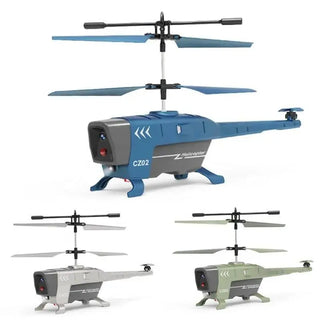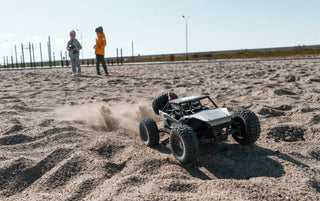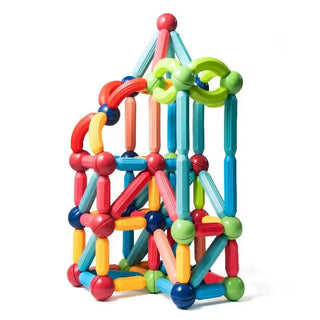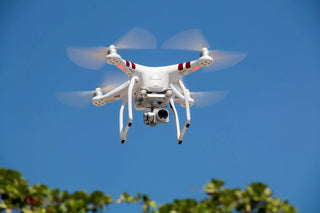UAV drones, once mainly seen in military settings, are now buzzing into everyday life. From delivering packages to monitoring crops, these flying gadgets are reshaping industries. With tech getting better, drones are set to change how we do things, making tasks quicker and more effective. This piece dives into the latest in UAV drone tech and where they might take us next.
Key Takeaways
- UAV drones are getting smarter with AI and advanced sensors, boosting their decision-making skills.
- In cities, drones are being looked at for things like air taxis, aiming to ease urban travel.
- Industries like construction and telecom are finding new ways to use UAVs to get more done.
- New rules are being crafted to let drones fly further, opening up more delivery and inspection options.
- Eco-friendly tech is being added to UAVs, cutting down their environmental impact.
Innovations in UAV Drone Technology

Advanced Sensor Integration
In the world of UAV drones, sensors are like the eyes and ears, and they're getting a major upgrade. Advanced sensors are transforming drones into more perceptive and intelligent machines. High-resolution cameras are now standard, capturing stunning detail and enabling precise aerial photography. Multispectral sensors are becoming essential in agriculture, helping farmers monitor crops and optimize yields. LiDAR systems, which use laser light to measure distances, are revolutionizing mapping and surveying, providing incredibly detailed topographical data.
AI and Machine Learning Applications
AI and machine learning are the brains behind the operation, making drones smarter and more autonomous. With AI, drones can make decisions on the fly, avoiding obstacles and optimizing flight paths without human intervention. Machine learning allows drones to learn from past flights, improving their performance over time. This means they can handle complex tasks like tracking moving objects or conducting detailed inspections with minimal oversight.
- Autonomous decision-making
- Real-time obstacle avoidance
- Performance improvement through learning
Enhanced Battery Life and Efficiency
Battery life has always been a limiting factor for drones, but that's changing. New battery technologies are extending flight times, allowing drones to fly longer and cover more ground. Lithium-sulfur batteries are leading the charge, offering higher energy density and longer life. Solar-powered drones are also on the horizon, promising even more extended flights without frequent recharges. Fast-charging technologies are reducing downtime, making drones more efficient and ready for action whenever needed.
With these advancements, UAV drones are not just flying machines; they're becoming indispensable tools in various fields, from agriculture to entertainment. The future of drone technology is not just about flying longer or farther, but about making smarter, more capable machines that can adapt to our needs.
Applications of UAV Drones in Commercial Aviation

Cargo Delivery Innovations
UAVs are really shaking up how we think about moving stuff from one place to another. They can zip packages around much faster than the usual delivery trucks, especially in places that are hard to get to. Imagine getting your online orders in just a few hours instead of days! Plus, using drones can cut down on shipping costs, which is always a win. They can also reach remote areas where traditional vehicles can't, making them super handy in emergencies or for delivering important supplies.
Passenger Transport Potential
Flying in a drone might sound like something out of a sci-fi movie, but it's becoming more of a reality. Companies are working on drones that can carry people safely across cities. This could mean less traffic on the roads and quicker commutes. Some designs are even being tested for safety and efficiency. If this takes off, we might see a whole new way of getting around urban areas.
Infrastructure for Urban Air Mobility
For drones to really become a part of our daily lives, especially in cities, we need some serious infrastructure changes. Think new landing pads and charging stations popping up around town. Cities will also need to plan air traffic routes to keep everything safe in the skies. Regulations will play a big role here, helping to manage how drones operate in busy urban areas. It's a big task, but the potential benefits make it worth the effort.
With drones taking to the skies, the future of urban mobility looks set to change dramatically, offering faster, more efficient travel options.
Urban Air Mobility and UAV Drones

Aerial Taxis and Passenger Drones
Imagine zipping across the city in a drone taxi, dodging traffic jams like a scene from a sci-fi movie. Companies are working on passenger drones that promise quick and reliable transport over congested urban areas. These aerial taxis could cut down travel time drastically and help ease ground traffic. But it's not just about speed—safety is a big deal too. Engineers are testing these drones to ensure they can handle the skies safely.
Infrastructure for Urban Air Mobility
For drones to become a regular part of city life, we need the right setup. Think of it like building roads for cars but in the sky. New landing pads and charging stations are essential. Cities have to figure out air traffic routes to make sure drones and planes don't get in each other's way. And let's not forget the rules—regulations will guide how these drones operate in busy urban settings.
Regulatory Developments
Getting drones into city skies isn't just about tech; it's about rules too. Safety regulations must be in place to protect folks on the ground. Privacy is another concern—people want to know they're not being watched without consent. Public acceptance is key, so educating communities about the benefits of drones can help. It's all about finding a balance between innovation and safety.
Urban air mobility could change how we live in cities. Faster travel, less congestion, and a more connected urban environment are just the start. Embracing drones in our transport systems might lead to a future where getting from A to B is quicker and more efficient than ever before.
For those looking to experience the thrill of flying, the Hoshi JJRC JX02 Flying RC Helicopter offers an exciting glimpse into the world of drone aviation. It's designed for both kids and adults, providing a fun and user-friendly way to explore the skies.
Sustainable Technologies in UAV Drone Development
Lightweight Materials and Design
Drones are going through a bit of a makeover, all thanks to lightweight materials. Think of carbon fiber, aluminum alloys, and some advanced plastics. These materials help drones fly further and use less energy. It's like putting them on a diet, but for flying! By making them lighter, drones can cover more ground without needing a pit stop. This is a huge win for efficiency and performance.
Renewable Energy Sources
Switching to renewable energy is a game-changer for drones. Instead of relying on fossil fuels, they're tapping into solar panels, hydrogen fuel cells, and even wind energy. Imagine a drone with solar panels soaking up the sun while it flies—that's the future. This shift not only cuts down on carbon emissions but also makes drones more sustainable in the long run.
Drones powered by renewable energy are not just a dream; they're becoming a reality.
Reducing Carbon Footprint
The drone industry is all about going green these days. They're working on energy-efficient propulsion systems and setting up recycling programs for drone parts. Plus, manufacturers are pushing for more sustainable practices in their production lines.
The future of UAV technology is all about balancing innovation with environmental care. By embracing sustainable methods, the industry can make sure drones are a positive force in the world.
In the end, it's about making drones that are not only smart and efficient but also kind to our planet. These efforts are paving the way for a more eco-friendly future in aviation.
Future Trends in UAV Drone Development

Autonomous Flight Capabilities
The future of drones is all about flying on their own. These machines will soon be able to handle flights without human pilots. They'll rely on advanced sensors and smart software to navigate and make choices independently. This shift could mean:
- Lower operational costs
- Fewer accidents by cutting down human mistakes
- Better efficiency in how flights are managed
Integration with Smart Cities
Drones are set to become a big part of smart cities. They'll take on jobs like:
- Delivering packages fast and efficiently.
- Watching traffic and offering real-time data.
- Helping emergency services by giving aerial views of incidents.
Collaborative UAV Networks
The idea of drones working together is catching on. This involves multiple drones teaming up to finish tasks. Benefits include:
- Better data collection through teamwork.
- Wider coverage for watching and monitoring.
- Quicker response times in emergencies.
As tech moves forward, drones will become more a part of our everyday lives, changing how we think about moving stuff and people around.
Economic Impact of UAV Drones on the Aviation Industry
Job Creation and Workforce Development
The rise of UAV drones is opening up a whole new world of job opportunities. Manufacturing is booming with the need for skilled workers to build these high-tech machines. Maintenance is another area that's seeing growth, as technicians are essential to keep these drones in top condition. And let's not forget operations—pilots and operators are crucial for flying and managing these aircraft.
- Manufacturing: Skilled labor for drone construction
- Maintenance: Technicians to ensure optimal performance
- Operations: Pilots and operators for drone management
Cost Efficiency and Operational Savings
UAV drones are transforming the aviation industry by cutting down costs. They use less fuel compared to traditional aircraft, which means big savings on fuel expenses. Labor costs are also reduced since fewer people are needed to operate these drones. Plus, with advanced technology, maintenance costs are minimized, making drones a cost-effective solution.
- Lower fuel consumption
- Reduced labor costs
- Minimized maintenance expenses
Market Growth and Investment Opportunities
The UAV market is on the rise, attracting a lot of attention and investment. There’s a surge in funding for research and development, leading to innovative solutions. Partnerships between tech companies and aviation firms are becoming more common. New startups are emerging, focusing on cutting-edge UAV technologies.
- Increased R&D funding
- Partnerships between tech and aviation companies
- Emergence of innovative UAV startups
The economic impact of UAV drones is significant, reshaping the aviation industry and paving the way for a dynamic future in air travel.
The dual 4K camera foldable drone is a great example of how UAV technology is not just changing the aviation industry but also making advanced tech accessible for everyone, from hobbyists to professionals.
UAV drones are changing the way the aviation industry works. They help businesses save money and improve safety. If you want to learn more about how these drones are making a difference, visit our website for more information!
Conclusion
So, looking at all this, it's clear that UAV drones are really shaking things up in aviation. They're not just for military missions anymore. Now, they're buzzing around cities, helping with deliveries, and even eyeing the skies for passenger transport. With tech like AI and better batteries, these drones are getting smarter and flying longer. Sure, there are challenges, like figuring out the rules and making sure they don't crash into other planes. But as we keep pushing the tech forward, drones are set to become a big part of our everyday lives, making things easier and more efficient. It's an exciting time for aviation, and who knows what the skies will look like in a few years?
Frequently Asked Questions
What are UAV drones and how do they function?
UAV drones, often called drones, are flying machines that operate without a human pilot. They use tools like sensors and cameras to gather information or do specific jobs.
What new technologies are being developed for UAV drones?
UAV drones are getting upgrades with things like better sensors, electric motors, and smart AI to help them fly smarter and make choices on their own.
How might UAV drones be used in cities?
In urban areas, UAV drones could be used for flying taxis, delivering goods, and even managing traffic situations.
What challenges do UAV drones face in commercial use?
Challenges include making sure drones can safely share airspace with other aircraft, following rules and laws, and improving battery life for longer flights.
How do UAV drones impact the environment?
UAV drones are becoming more eco-friendly by using lightweight materials and renewable energy sources, which helps them use less fuel and reduce pollution.
What is the future of UAV drones in aviation?
The future looks promising with UAV drones becoming more common in tasks like delivering packages, helping in emergencies, and even transporting people.




















